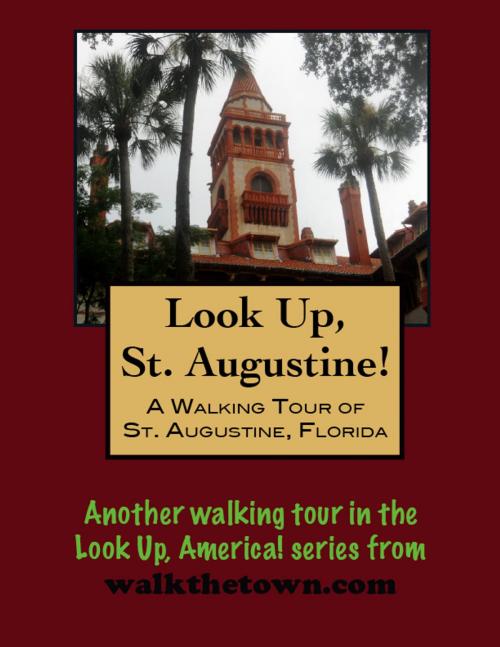| Author: | Doug Gelbert | ISBN: | 9781466101906 |
| Publisher: | Doug Gelbert | Publication: | July 13, 2011 |
| Imprint: | Smashwords Edition | Language: | English |
| Author: | Doug Gelbert |
| ISBN: | 9781466101906 |
| Publisher: | Doug Gelbert |
| Publication: | July 13, 2011 |
| Imprint: | Smashwords Edition |
| Language: | English |
There is no better way to see America than on foot. And there is no better way to appreciate what you are looking at than with a walking tour. Whether you are preparing for a road trip or just out to look at your own town in a new way, a downloadable walking tour is ready to explore when you are.
Each walking tour describes historical and architectural landmarks and provides pictures to help out when those pesky street addresses are missing. Every tour also includes a quick primer on identifying architectural styles seen on American streets.
Juan Ponce de Leon poked around this coast in 1513 and claimed the land for Spain. Afterwards both the French and Spanish attempted colonization in Florida but nothing took hold until 1565 when Spanish King Phillip II dispatched Pedro Menendez de Aviles to establish a base from which to attack the French. Menendex arrived in Florida on the feast day of St. Augustine of Hippo and named his landing site after the saint. From that day on the town has been continuously occupied, establishing St. Augustine as the oldest city in America.
It was not without struggle. The town was sacked by pirates and under regular threat or attack, especially as the English colonies began spreading down the American coast in the 1600s. As such St. Augustine evolved as a military post more than as an economic and cultural center. After the town was attacked and plundered by English privateer Robert Searle in 1688 the Spanish began in 1672 the construction of a more secure fortification, the Castillo de San Marcos, which still stands today as the nation's oldest fort.
As part of the Treaty of Paris ending the French and Indian War in 1763 the British received Florida in exchange for relinquishing control of occupied Cuba. Almost all of the more than 3,000 Spaniards sailed away, mostly to Cuba. The British were energetic stewards but the territory was ceded back to Spain by the United States in 1783 as recognition for their assistance in the American Revolution. Many of the St. Augustine exiles returned but by this time Spain was struggling to retain its distant colonies and it was only a matter of time before Florida would become a United States territory. It happened peaceably in 1821 by way of the Adams-Onis Treaty.
St. Augustine's military heritage continued under American rule. The town played a role in the Seminole Wars and the War Between the States and the old fort was a military prison during the Spanish-American War. Only in 1898, after more than 200 years as an active fort under five different flags was the Castillo de San Marcos deactivated.
Henry Flagler, a failed salt miner, went into the oil refining business with John D. Rockefeller in 1867 and they built the biggest business empire in the world. Although Rockefeller's is the name most associated with Standard Oil, he always gave the credit to its success to Flagler. On a wedding trip to Florida with his second wife in 1881 the Flaglers visited St. Augustine where they were charmed with the town's Old World Spanish flavor. In short order Flagler gave up day-to-day operations at Standard Oil and set about developing St. Augustine as "the Newport of the South." His vision would soon extend down the peninsula, however, extending his railroad and development all the way to Key West by 1912. What Flagler started in St. Augustine with a 540-room hotel would grow into a personal bet of $50 million on the future of Florida.
Over the years St. Augustine has tried to maintain that Spanish charm that bewitched Henry Flagler 130 years ago and to see how they've succeeded we will begin at the busy Visitor Center...
There is no better way to see America than on foot. And there is no better way to appreciate what you are looking at than with a walking tour. Whether you are preparing for a road trip or just out to look at your own town in a new way, a downloadable walking tour is ready to explore when you are.
Each walking tour describes historical and architectural landmarks and provides pictures to help out when those pesky street addresses are missing. Every tour also includes a quick primer on identifying architectural styles seen on American streets.
Juan Ponce de Leon poked around this coast in 1513 and claimed the land for Spain. Afterwards both the French and Spanish attempted colonization in Florida but nothing took hold until 1565 when Spanish King Phillip II dispatched Pedro Menendez de Aviles to establish a base from which to attack the French. Menendex arrived in Florida on the feast day of St. Augustine of Hippo and named his landing site after the saint. From that day on the town has been continuously occupied, establishing St. Augustine as the oldest city in America.
It was not without struggle. The town was sacked by pirates and under regular threat or attack, especially as the English colonies began spreading down the American coast in the 1600s. As such St. Augustine evolved as a military post more than as an economic and cultural center. After the town was attacked and plundered by English privateer Robert Searle in 1688 the Spanish began in 1672 the construction of a more secure fortification, the Castillo de San Marcos, which still stands today as the nation's oldest fort.
As part of the Treaty of Paris ending the French and Indian War in 1763 the British received Florida in exchange for relinquishing control of occupied Cuba. Almost all of the more than 3,000 Spaniards sailed away, mostly to Cuba. The British were energetic stewards but the territory was ceded back to Spain by the United States in 1783 as recognition for their assistance in the American Revolution. Many of the St. Augustine exiles returned but by this time Spain was struggling to retain its distant colonies and it was only a matter of time before Florida would become a United States territory. It happened peaceably in 1821 by way of the Adams-Onis Treaty.
St. Augustine's military heritage continued under American rule. The town played a role in the Seminole Wars and the War Between the States and the old fort was a military prison during the Spanish-American War. Only in 1898, after more than 200 years as an active fort under five different flags was the Castillo de San Marcos deactivated.
Henry Flagler, a failed salt miner, went into the oil refining business with John D. Rockefeller in 1867 and they built the biggest business empire in the world. Although Rockefeller's is the name most associated with Standard Oil, he always gave the credit to its success to Flagler. On a wedding trip to Florida with his second wife in 1881 the Flaglers visited St. Augustine where they were charmed with the town's Old World Spanish flavor. In short order Flagler gave up day-to-day operations at Standard Oil and set about developing St. Augustine as "the Newport of the South." His vision would soon extend down the peninsula, however, extending his railroad and development all the way to Key West by 1912. What Flagler started in St. Augustine with a 540-room hotel would grow into a personal bet of $50 million on the future of Florida.
Over the years St. Augustine has tried to maintain that Spanish charm that bewitched Henry Flagler 130 years ago and to see how they've succeeded we will begin at the busy Visitor Center...















